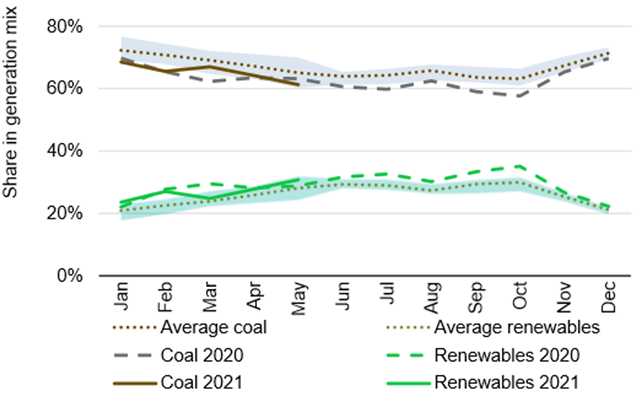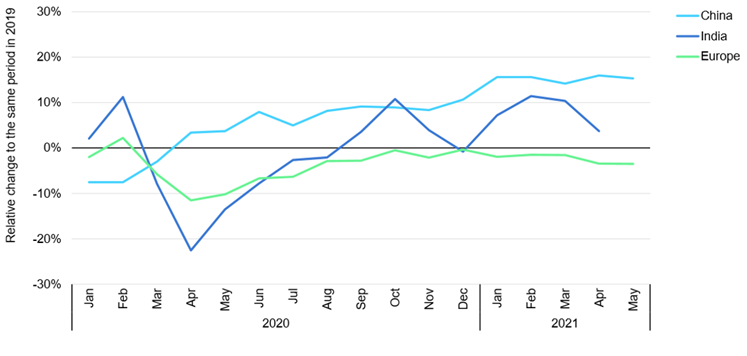Demand, coal recovers from COVID: IEA
The International Energy Agency (IEA) has released its latest electricity market report that shows the impact of the COVID-19 pandemic, as well as a rebound in electricity demand this year in some regions. Next year is also expected to see solid growth in demand for electricity in specific regions.
What may come as a surprise is that the report also points to an increase in coal-fired generation, which is expected to surpass pre-pandemic levels in Asia Pacific over the next two years.
That’s one outcome as a result of the scale of demand growth – expected to be up 5 per cent this year and 4 per cent next year, with most of this growth coming from our neighbourhood. The rebound is “very region specific”. China is expected to account for more than half of the demand in the next year, while 9 per cent of global demand is expected to come from India which is now the third biggest consumer of electricity.
While renewable generation is forecast to continue to grow strongly, it won’t be able to keep up with demand. Despite increasing by an anticipated 8 per cent this year and more than 6 per cent next year, renewables are only expected to be able to satisfy around half the global demand growth this year and next. The IEA report notes that nuclear generation will only be able to meet some of the shortfall and is only expected to increase 1 per cent this year and 2 per cent next.
Most of the slack (45 per cent) is expected to be met by fossil fuel plants this year and 40 per cent of the demand will be met by coal generation next year. After dropping by 4.6 per cent last year globally coal-fired generation is expected to grow by 5 per cent this year, to exceed pre-pandemic levels and it is forecast to grow a further 3 per cent next year. This will take coal generation to a new record.
Gas-fired generation fell by 2 per cent last year, but is expected to grow 1 per cent this year and by close to 2 per cent next year. The lower growth for gas reflects the fact that it plays a smaller role in Asia Pacific, while it faces greater competition from renewables in both the US, which has a large gas-fired generation fleet, and in Europe.
Recently the IEA released a Net-Zero Emissions by 2050 Scenario which projected that nearly three quarters of the carbon emissions reductions would come from the power sector – this was based on coal-fired generation falling by more than 6 per cent a year with gas picking up some of this and growing 5 per cent. So this latest assessment appears to make that outlook harder to achieve.
In fact, the IEA expects carbon emissions from the electricity sector to increase by 3.5 per cent this year and by a further 2.5 per cent in 2022, which it notes would take them to an all-time high.
China
China reported 4 per cent growth in demand last year and in the first quarter of this year, weather-adjusted[i] growth was up 22.5 per cent on the comparable quarter last year (there was a 6 per cent drop in Q1 2020 due to lockdown measures. And compared to the pre-pandemic levels in 2019 the first quarter was up a remarkable 15 per cent. The growth seen in the first quarter this year, weather-corrected growth was 15 per cent and 16 per cent in April and May respectively (compared to 2019).
From late last year through to the early part of this year the proportion of coal in China’s generation mix rebounded from record lows seen in the earlier part of 2020. Apart from the higher demand, coal generation was helped by the reduced availability of hydro generation because of drier weather. Record amounts of renewables between July and October last year had reduced coal to a record low of 58 per cent in October. Since November it has recovered and in the first four months of 2021 its share of the generation mix had increased to 66.5 per cent which is higher than in the same periods for the preceding two years.
The IEA notes the shift back to coal was not entirely unsurprising because renewables generation is highly seasonal and as a result by May coal’s share had fallen to 61 per cent. The graph below shows the changing share for both coal and renewables in China’s grid.
Figure 1: Share of coal and renewables China

Source: IEA
India
While not as dramatic as China’s demand growth in the first quarter, India still saw electricity demand that was nearly 10 per cent higher than the same period in 2019. While India was hard hit by COVID-19 by mid-April this year, which slowed the demand growth, its electricity demand was still up 7 per cent compared to April 2019. Growth in May was 6 per cent higher compared to the same period pre-pandemic.
Coal’s monthly share of generation in India in early 2021 sat at 79 per cent. In the past two years, coal and renewables have both increased faster than overall generation and this has been at the expense of nuclear and gas generators.
Europe
Europe in contrast saw weather-corrected demand decline gradually from the start of 2021 and in May this year the aggregated weather-adjusted electricity demand for France, Germany, Spain, Italy and the UK was down 3 per cent compared to 2019. The IEA reports that the current trend for European electricity demand is unclear and is far from showing a complete recovery from the impact of the pandemic.
Changes in demand for China, India and Europe are shown in Figure 2 below.
Figure 2: Change in electricity demand compared to 2019 (pre-pandemic conditions)

Source: IEA
[i] This removes the variability between periods to allow comparison of demand under the same weather conditions to see underlying trends.
Related Analysis
International Energy Summit: The State of the Global Energy Transition
Australian Energy Council CEO Louisa Kinnear and the Energy Networks Australia CEO and Chair, Dom van den Berg and John Cleland recently attended the International Electricity Summit. Held every 18 months, the Summit brings together leaders from across the globe to share updates on energy markets around the world and the opportunities and challenges being faced as the world collectively transitions to net zero. We take a look at what was discussed.
Great British Energy – The UK’s new state-owned energy company
Last week’s UK election saw the Labour Party return to government after 14 years in opposition. Their emphatic win – the largest majority in a quarter of a century - delivered a mandate to implement their party manifesto, including a promise to set up Great British Energy (GB Energy), a publicly-owned and independently-run energy company which aims to deliver cheaper energy bills and cleaner power. So what is GB Energy and how will it work? We take a closer look.
Delivering on the ISP – risks and opportunities for future iterations
AEMO’s Integrated System Plan (ISP) maps an optimal development path (ODP) for generation, storage and network investments to hit the country’s net zero by 2050 target. It is predicated on a range of Federal and state government policy settings and reforms and on a range of scenarios succeeding. As with all modelling exercises, the ISP is based on a range of inputs and assumptions, all of which can, and do, change. AEMO itself has highlighted several risks. We take a look.
Send an email with your question or comment, and include your name and a short message and we'll get back to you shortly.



